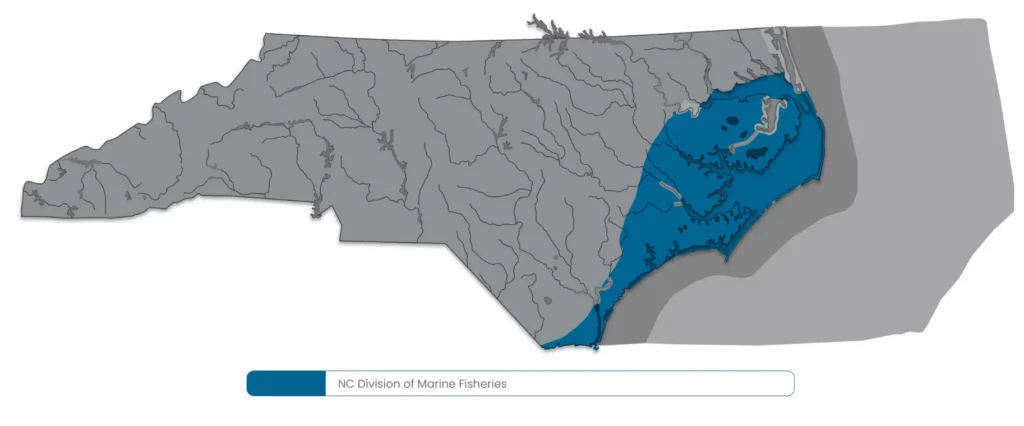North Carolina Marine Fisheries Commission (MFC) & North Carolina Division of Marine Fisheries (DMF)

Who They Are
The North Carolina Marine Fisheries Commission is one of two state rulemaking bodies responsible for managing jurisdictional waters within North Carolina. The North Carolina Marine Fisheries Commission functions as a quasi-judicial agency established within the Department of Environmental Quality.
The North Carolina Marine Fisheries Commission consists of nine members appointed by the Governor as follows: three persons representing commercial fishing or the commercial fishing industry, three persons engaged in recreational fishing or the recreational fishing industry, two at-large appointments, and one scientist. Members must also be residents of certain coastal geographic areas.
The North Carolina Division of Marine Fisheries is established as a “subunit” of the North Carolina Department of Environmental Quality. The Secretary of the North Carolina Department of Environmental Quality, who is appointed by the Governor, selects a Director for the North Carolina Division of Marine Fisheries and may delegate powers and duties to the Director.
Staff biologists with the North Carolina Division of Marine Fisheries prepare and amend fisheries management plans for adoption by the North Carolina Marine Fisheries Commission for all commercially or recreationally significant species or fisheries as outlined in North Carolina General Statutes.
Where They Manage
Jurisdictional waters within North Carolina are determined by agreement between the North Carolina Marine Fisheries Commission and the North Carolina Wildlife Resources Commission. These two state agencies currently maintain three formal delineations: Coastal Fishing Waters, Inland Fishing Waters, and Joint Fishing Waters.
Coastal Fishing Waters are managed under the authority of the North Carolina Marine Fisheries Commission and include the Atlantic Ocean, the various coastal sounds, and estuarine waters up to the dividing line between Coastal Fishing Waters and Inland Fishing Waters as agreed upon by the two state agencies. Regulations and licensing of fishing in Coastal Fishing Waters are under the jurisdiction of the North Carolina Marine Fisheries Commission; except that certain inland game fish (such as Largemouth Bass and Sunfish) are subject to regulations by the North Carolina Wildlife Resources Commission in Coastal Fishing Waters.
How They Function
Fishery management plans for 13 marine and estuarine species that fall within North Carolina’s jurisdictional state waters are developed by the North Carolina Division of Marine Fisheries and presented for approval to the North Carolina Marine Fisheries Commission. While the North Carolina Marine Fisheries Commission can act independently of recommendations presented to them by the North Carolina Division of Marine Fisheries, a supermajority (six of the nine members) is necessary to override recommendations regarding measures proposed to end overfishing or to rebuild overfished stocks as described in North Carolina General Statute 143B-289.52(e1).
While rulemaking authority lies within the North Carolina Marine Fisheries Commission, the Director of the North Carolina Division of Marine Fisheries has proclamation authority to regulate seasons, areas, size limits, and creel limits for fisheries within jurisdictional waters. Proclamation authority allows for a quicker management response than otherwise provided through the rulemaking process. A notable example includes seasonal openings and closings of fisheries managed through quota monitoring by proclamation of the Director. The North Carolina Marine Fisheries Commission also develops rulemaking to comply with federal fisheries regulations established in the Atlantic Ocean under the jurisdiction of the Atlantic States Marine Fisheries Commission, the South Atlantic Fishery Management Council, and the Mid-Atlantic Fishery Management Council.
The North Carolina Marine Fisheries Commission appoints the following standing advisory committees: Finfish Committee, Shellfish/Crustacean Advisory Committee, Habitat and Water Quality Committee, Northern Regional Advisory Committee, Southern Regional Advisory Committee, and a Shellfish Cultivation Lease Review Committee. The North Carolina Marine Fisheries Commission considers findings and recommendations from these advisory committees as described in North Carolina General Statute 143B-289.57.
Species They Cover
There are 13 species or species groups identified in North Carolina General Statutes (1997 Fishery Reform Act) that are managed and regulated by the North Carolina Marine Fisheries Commission and the North Carolina Division of Marine Fisheries within jurisdictional state waters.
These species include Bay Scallop, Blue Crab, Eastern Oyster, Hard Clam, Kingfishes, Red Drum, River Herring, Sheepshead, Shrimp, Southern Flounder, Spotted Seatrout, Striped Bass (Albemarle Sound and Roanoke River), Striped Bass (Central Southern Management Area), and Striped Mullet.
